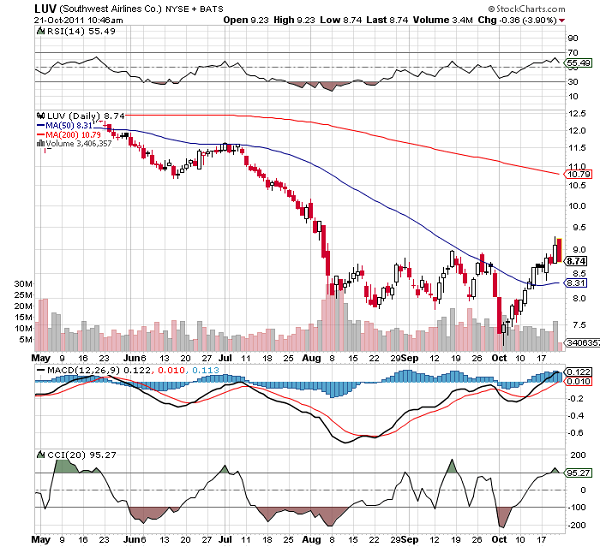In light of the upcoming weekend summit of Euro zone leaders to discuss a potential solution to the debt crisis plaguing the region, markets have been fluctuating between hope and despair as news of a potential breakthrough is countered with denials of a solution to the problem being around the corner.
As tension mounts over the details of the plan to leverage the EFSF, further restructure Greek debt, recapitalize banks, and issue new economic governance, the markets are expected to be a roller-coaster ride going into the upcoming summit.
While tensions have been high in global markets, the time for investors to get off of the roller-coaster has apparently not arrived as of yet, and opportunities for realizing investment gains and protecting profits are present in today’s market.
A potential play for increased profits could come from an industry that has endured its share of pain in the last year, the airline industry. While there has been a number of setbacks within the industry itself – namely the high cost of jet fuel – there may be one airline company stock that is set for liftoff, discount carrier Southwest Airlines (LUV).
Southwest Disappoints On Earnings – Sort of
Southwest Airlines delivered another seeming blow to the struggling industry on Thursday, as the discount carrier posted a third-quarter loss, coming just one day after AMR Corp, parent company of American Airlines, posted its own disappointing earnings on Wednesday.
The third-quarter loss by Southwest Airlines was due largely to bets made by the company on volatile fuel prices. Due to the fact that fuel costs can represent as much as 30% of an airlines’ costs, airlines use fuel hedging bets on oil price directions as a check on fuel costs.
Southwest Airlines made some bad bets this quarter, resulting in a loss of $140 million, versus a 2010 profit of $205 million for the same quarter. If hedging and additional one-time items were to be excluded, however, the carrier actually had a solid third-quarter, with a smaller profit of $0.15 per-share, which still beat Wall Street estimates by $0.01.

Investors shrugged off the hedging loss on Thursday, and Southwest’s stock price surged 4.5% to close at $9.10. Although the stock was trading lower on Friday, strong fundamentals and technical indicators could mean that Southwest Airlines could provide you with near and long-term investment gains.
Could Southwest’s Promising Future Translate Into Investment Gains?
The United States’ largest discount carrier raised fares and filled planes over the past summer, and looking toward the year’s end shows solid bookings. This suggests that air travel is holding up, even in light of fears that the weak economy may cause companies and consumers to cut back.
Confidence in demand led Southwest Airlines as well as other carriers to raise fares this week, marking the first broad-based increase in prices since the summer. While the industry is in he midst of a uneasy recovery that started last year but which is now being threatened by economic worries and rising fuel prices, analysts predict that the combined effect of raising fares and Southwest’s results should bode well for the airline industry.
Southwest can also credit the May acquisition of AirTran Airways for the 35% rise in quarterly revenue which beat the analysts’ forecast of $4.17 billion. Officials at Southwest Airlines have stated that they are making progress in integrating AirTran’s operations into Southwest.
Southwest has already saves $60 million in annual costs by renegotiating contracts with AirTran, as well as reducing overhead, resulting in an expected $400 million in savings for the carrier per year.
Southwest currently pays a small dividend of $.02 (0.20%) per-share, and has an analysts’ price target of $13.71, which could translate into investment gains for your portfolio with a combination of upside potential and dividend income. Take advantage of the upcoming market volatility to watch for buying opportunities in this security that is poised for possible high flying returns.
Comments (No)